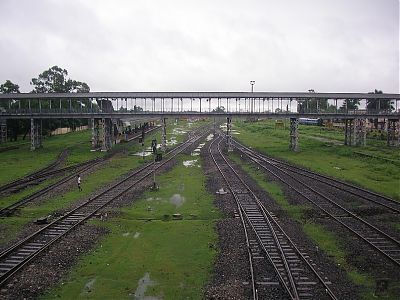Sikkim
You can take any bus
June 16, 2008

When I first was heading toward Siliguri (or actually, when I finally was headed for somewhere, and it was to Siliguri), I had thought I might have to fly if the trains were all booked. It was suggested that Indian tourists would be more likely to have booked all the train travel, and I’d have to fly out. As it turned out, I was able to get a train ticket, and I only had to pay Rs 300 more than the listed fare (about half the ticket price). It was still cheaper than the plane ticket.
At various times it was also thought I might go to Kalimpong on one day and try to get out the next – not only was there the problem of the roads into Siliguri blocked, but reports of three times more people than hotel rooms, a nighttime curfew, and riots were all coming out of there. From minute to minute it was hard to know what to believe.
Once we finally headed out (in the neighbor’s private car) I wanted to stop in Rangpo (just inside the border) to stock up on cash. But one of the town’s bank’s network was down, and the other bank had an electrical problem which shut down the ATM. Neither could I exchange money there – the only place for foreign exchange in Sikkim is in Gangtok. Someone told us there was an ATM at the college up the road, so we headed back again ( I saw the “Thanks for visiting Sikkim” farewell sign three times that day). Then on the long and bumpy road down we had a flat tire, but we were able to change it and continued down.
Although my phone had worked for a little while when I left Siliguri two months ago, the service never returned. In the morning I was able to get a SIM card but the only shop open was for Reliance, which doesn’t seem to have great coverage. I was told it would work in Assam (with roaming charges), but now that I’m here it’s nothing more than a pocketwatch.
Guwahati, where I’m staying now, is hot but pleasantly breezy, and so far it hasn’t rained. I visited one of the temples – Kamakhya, center of Tantric worship, where animals are ritually slaughtered inside every day (and in about a week a massive festival will occur in which more blood is spilled to celebrate the goddess’s menstrual cycle). The line to get in required you to wait in a locked cage (the doomed goats, on the other hand, were allowed to wander freely around the complex butting heads with each other). I did not go inside. Instead I went up the road to the nearly deserted – but much more pleasant – Bubaneshwari Temple. It’s on the hilltop with a magnificent view of the Brahmaputra and the hills around the city. There I met a bunch of kids who gave me a death-defying ride back down on their motorcycles, as well as some rather strong supari.